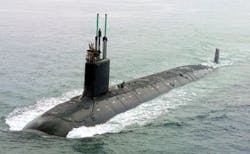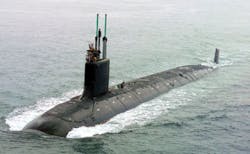By John McHale
WASHINGTON - U.S. Navy officials say that embracing commercial-off-the-shelf (COTS) technology and shortening the technology refresh time for electronic payloads is crucial to maintaining the superiority of the fleet.
Captain Brian Vance of the Program Executive Office of Submarines in San Diego made the comments at the Navy League Symposium in Washington last month.
“We want to maximize COTS usage,” Vance said. Open architectures and open source software are all in play, Vance says. He mentioned that the Navy plans to build on the success of the Acoustics Rapid COTS Insertion program-better known as A-RCI.
A-RCI is a sonar system upgrade installed on all classes of Navy submarines. The system integrates and improves the processing of data from sensors including the towed array, hull array and sphere array. These improvements are achieved by use of COTS-based hardware and software that speeds processing while enhancing fidelity. Lockheed Martin is the prime contractor for A-RCI.
The A-RCI program provides common sonar systems within an open systems architecture that exploits commercial computing technology, enabling powerful algorithms to detect and classify the slightest underwater sounds.
The A-RCI program uses a process called the Advanced Processing Build (APB) to drive greater advances in the program. This practice provides a “competitive window” through which improvements are assessed and evaluated across the entire technology base. The APB process leverages developments across surveillance, surface, and submarine programs to get the most from U.S. Navy and industry R&D investments, and it allows robust small business participation.
Vance says the Navy is still using the APB to integrate new technology.
The current submarine technology insertion period is approximately two years, Vance says. The Navy’s goal is to get that down to 35 days per submarine, he adds. Ideally, Navy officials would prefer that the only maintenance time would be when the ship was getting a refresh, Vance says.
Right now the process is for every other submarine to go into port to get retrofitted, Vance says.
One of the next steps Vance and his team will be addressing is managing the decision making for commanding officers (CO) on the submarine. In the past the systems did not provide all that much data for the CO, “we have the capability to overwhelm the CO with information.”
Integrating technology based on open and modular architectures will help solve this problem, thereby improving network centricity.
The open architecture approach is being looked at in other Navy programs especially with the Littoral Combat Ship and unmanned undersea vehicles, Vance says.




